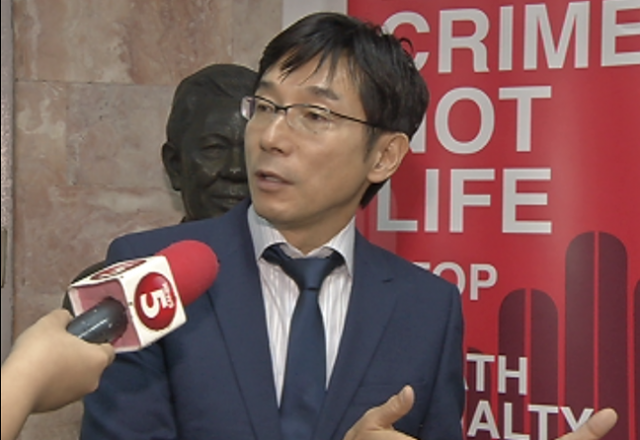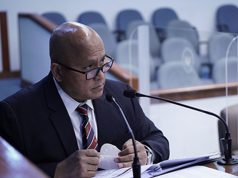When Japanese photographer Toshi Kazama found out that he was going to take pictures of a 16-year-old killer on death row in the United States, he expected to find a monster.
But when he finally met the teenager, what he found was an intellectually disabled boy who could easily have been sitting in his son’s classroom.
Charged with two counts of murder, the boy had confided in Kazama that he was afraid to shower because the adult inmates would rape him in the bathroom.
“I started to think, what if I was born the same? I want to treat him as I would want to be treated. So I started to treat others the way I wanted myself to be treated. That really changed my whole life for me,” Kazama said, speaking on Monday at the Commission on Human Rights in a forum against the death penalty.
“People think, ‘as long as I’m fine, I don’t care about others.’ But meeting him just changed my whole experience.”
Thankfully, the 16-year-old was spared the death penalty when the U.S. Supreme Court abolished capital punishment for juvenile offenders in 2005.
Since 1996, Kazama has been visiting prisons in the U.S. and other countries, photographing juvenile death row inmates, meeting families, victims, victims’ families, and executioners.
He was in the Philippines to present an exhibit of his photos at the Senate’s public hall, and to advocate against the death penalty.
He recalled visiting an execution chamber in Taiwan, where the floor was filled with black sand. The inmate would have his last meal in front of an image of Buddha, then he would lie down on a sheet. The executioner would then shoot him until he died. The black sand would absorb the bullet’s impact, and the blood.
“To me, death penalty is reality. It’s not just an idea … As I see the execution chambers, and there are many executioners, I see how the human life is being snuffed,” the photographer said. “And many of the executioners are normal prison guards. They all say they don’t want to kill any more human beings. While society pushes to reinstate the death penalty, someone has to kill a human being. And yes, you don’t want to kill somebody with your own hand. But you ask somebody [else] to do it. When death penalty is reinstated in this country, and when execution resumes, somebody has to kill for you.”
He hoped to have the chance to meet the Filipino senators one by one to talk to them about the realities of death penalty.
“We have to stop. Please keep this country away from death penalty,” Kazama said.
He remembered an execution where, five minutes before it was to be carried out, the phone rang. The guards cheered, expecting it to be the governor calling to halt the proceedings.
Indeed it was the governor, but, sounding drunk, he was just calling to say they should push through with the execution.
“To him, execution is just a piece of paper in front of him. Just to sign a paper, it’s only a matter of paper to him. He never comes here to witness or administer any execution. It’s almost like us … Execution is the farthest event from our daily lives … We are trying to distance [ourselves]. I was one of them too,” Kazama said.
He urged Filipinos to stop the reimposition of the death penalty, which President Rodrigo Duterte had asked Congress to do in his last State of the Nation Address. The House of Representatives approved the measure to reinstate the death penalty, for drug-related offenses, in March.
The Philippines had done “an amazing job” abolishing the death penalty during the time of then President Gloria Macapagal-Arroyo, making the nation a “jewel in Asia,” Kazama said.
Reinstating the death penalty would just legalize extrajudicial killings, he added.
With Kazama, representatives from CHR, from the Coalition for the Abolition of Death Penalty in ASEAN, ASEAN Youth Forum, iDefend, and Participatory Education on Rights Awareness and Social Action called on the Philippine government to “End Crime, Not Life”.
CHR Commissioner Karen Gomez-Dumpit said they would continue to work against the reimposition of the death penalty, and propagate the studies proving that the death penalty did not deter crime. The CHR also planned to conduct a nationwide survey to see how Filipinos really felt about the death penalty.
Dumpit said that she was one in the quest for justice, which was the motivation for many people who were for the death penalty.
She stressed that the CHR did not want any crime to go unpunished; this was not how human rights worked. Rather, what the CHR was for was due process. The rule of law must be followed, and there must be humane treatment for those who had committed crimes.
Death was an inhuman verdict, and was tantamount to punishing people for the failure of the justice system. The taking of life was permanent, she added. Mistakes could not be rectified.
For her part, iDefend’s Nilda Sevilla estimated that about eight to ten senators were against the death penalty, and she hoped they would be firm in their stance.










